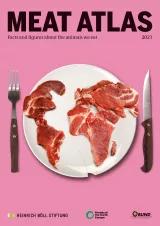
Trade in meat and live animals is relatively new and growing fast. Disease outbreaks, sanitary restrictions and trade policies can lead to big swings in trade flow. The big four players are China – which dominates import markets – as well as the USA, Brazil and the EU, which provide most exports.

Just under 38 million tonnes of meat, comprising around 11 percent of annual global production, are traded across national borders each year. Although the vast majority of meat stays in the country where it is produced, the share traded internationally is growing steadily. In the 1960s, less than 4 percent of worldwide beef production was traded across borders; now, it is almost 20 percent. For poultry the share is around 12 percent; for pork, 11 percent.
The reduction of customs tariffs and quotas through the World Trade Organization is one reason for the growing trade in meat and meat products. But many countries still use tariffs to protect their meat sector, and strict rules to contain livestock diseases hinder many developing countries from exporting their meat products. This may be because they do indeed have problems with particular diseases, or because they lack the laboratory capacity and institutional structures to prove that they are disease-free.
In any case, livestock diseases are the main reason for the fragility of international trade flows in meat. Trade may increase markedly over a very short period, or be cut off abruptly. The temporary collapse in the market for poultry in Southeast Asia with the emergence of bird flu in 1997, and the complete collapse of British beef exports in the 1990s after the spread of BSE in the United Kingdom, show how embargoes can dry up trade flows almost overnight. After the latter outbreak, the European Commission imposed a worldwide ban on exports of British beef and beef products.
In contrast, global trade actually profited from the outbreak of African swine fever. The disease caused Chinese pork production to drop by almost 20 percent. As a result, in 2019, China imported 2 million tonnes – 62 percent – more meat than in the previous year. World trade rose by around 6.9 percent. The biggest winners were Brazilian producers, which supplied record amounts of poultry and pork to China. The EU also expanded its exports: in the first half of 2020, its pork exports were 15 percent above the same period in the previous year, mainly because exports to China doubled. The situation was reversed in late summer 2020, when African swine fever reached Germany. Customers such as China, South Korea and Japan stopped imports from Germany. The European Commission revised its positive estimate for exports for 2020, and forecast a drop of 10 percent by the end of 2021.
The meat trade is also a favoured means of exerting political pressure. Russia banned the import of meat and cheese from Europe as a consequence of the EU sanctions following the Russian annexation of Crimea. China slowed beef imports from Australia after the government in Canberra accused China of being the source of the Covid-19 pandemic. And Saudi Arabia banned poultry imports from Brazil as a warning to that country not to move its embassy in Israel from Tel Aviv to Jerusalem.
Overall, livestock disease, sanitary restrictions and trade policies are likely to remain the main factors driving or limiting the development of trade in meat. Things were different in the past. In the 1960s and 1970s, very little meat was traded internationally due to its perishability. The big shift occurred through technological advances that made frozen or refrigerated transport possible.
The number of live animals traded has also risen steadily. In 2017 – the year with the most recent data available – almost 2 billion live animals were traded, and since 2003 the global market has doubled to about 24 billion euros. Poultry make up by far the greatest amount of livestock traded, though other species are also shipped live. Pigs are destined mainly for the USA and Poland, while most sheep and cattle are sent to the Arab world. Overall, a large proportion of live animals are traded regionally. Some 70 percent of the animals traded by the EU are moved from one member country to another, with each country handling a different part of the value chain. Piglets born in Denmark, for example, are taken to Poland for fattening. Land transport is limited to a maximum of 8 hours a day. But there is no time limit for animals loaded onto ships: their journey may last for weeks.
Worldwide demand for meat is forecast to continue to grow over the next decade. The OECD and FAO predict that global meat production will rise by almost 13 percent between 2019 and 2029, and that international trade will grow by 12 percent. The most important market player is China, with its huge demand pulling in around one-third of world imports. Developing countries will also import more as their rapidly rising demand outstrips local supply, and as many small-scale local producers struggle to compete with cheap imports.
Exports are also concentrated in a small number of countries. The three biggest exporters, Brazil, the USA and the EU, will account for around 60 percent of all meat exports by the end of the decade, according to FAO. Demand for meat is already saturated in many developed countries and is likely to fall. Depending on how production conditions change, the EU and the US will increasingly focus their production on serving the export market.


